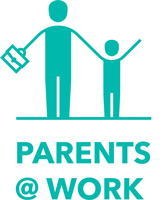Information and communication
Informing yourself about supportive measures and legal regulations, and communicating about these with your employees, is extremely important for arriving at a successful family and gender-friendly policy. Moreover, employees who can share knowledge and advice between each other in an informal manner will feel supported and will have an outlet for problems with their work-life balance.
There are several ideas for actions you can set up around this too.
Set up networking or peer coaching at your company.
New parents are given a great deal of information, from official bodies, media, friends and family, etc. But what about information on the work-life balance at your company? No-one can give better tips than colleagues who are also parents. Get your employees to exchange information amongst themselves, on parenthood, the work-life balance, informal care and so on.
It is definitely a good idea to put the idea out there as an employer and sound your employees out for any interest. You can also provide the underpinning for this, such as making a room available, providing drinks and snacks, setting up a page on the intranet to share information, etc.
Be sure to try and bring together employees from all levels, services and ages here. You might take part yourself, as a parent or a carer.
Encourage a few role models at your company to speak.
Getting information from ‘peers’ is still the best way for people to empathise and feel connected. Another option might therefore be to highlight several ‘experts from experience’ at your company, such as
- a project manager who has taken paternity leave;
- an administrative worker who has taken informal care leave to care for his ill mother;
- an executive who has begun working part-time to care for her 3 children.
If they consent to it, you can give these people, each with their own story, a voice in an interview and share this testimony with colleagues (through a network, the intranet, an e-mail, etc.).
Why not put these testimonies, with the consent of those involved, on your website too, on your vacancies page for example? This shows that you have regard to work-life balance and gender equality as a company, which are two good signposts for attracting new talent.
Provide information on legal obligations and arrangements at your company.
The checklists within the toolkit discuss a great many legal obligations around leave, submitting administrative documents, tackling discrimination and so on. This information is not only useful for you as an employer, but also for your employees. Share this information with your employees, for example through an information session.
Do you want to be sure that every employee has received all the information? Hold the information session during working hours, or pay it as overtime (for shift systems, for example).
Are you not quite sure you can convey the correct legal information yourself? Then by all means bring in an external expert, such as your Social Secretariat.
Bring up the work-life balance in performance reviews, development reviews, progress reviews, etc.
Indicate when announcing the interview that wishes, expectations or challenges relating to the work-life balance can be discussed. This allows your employee to anticipate this and think about it. That way, results and difficulties at work are often easier to put into context, and the real causes can be tackled.
Please note: Would your employee prefer not to talk about this? This is okay too. You can then indicate that there are other people she/he can turn to, such as a confidant or other colleagues.

